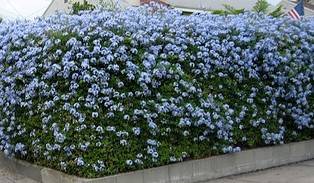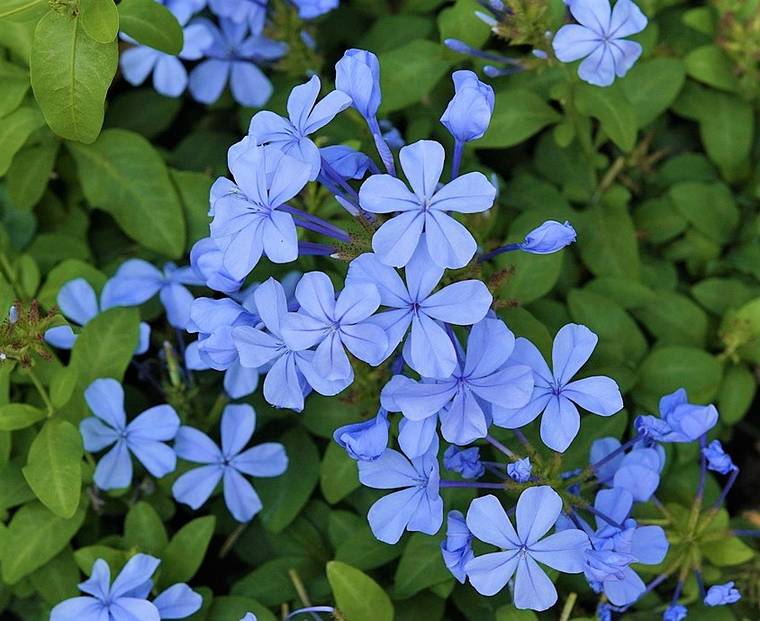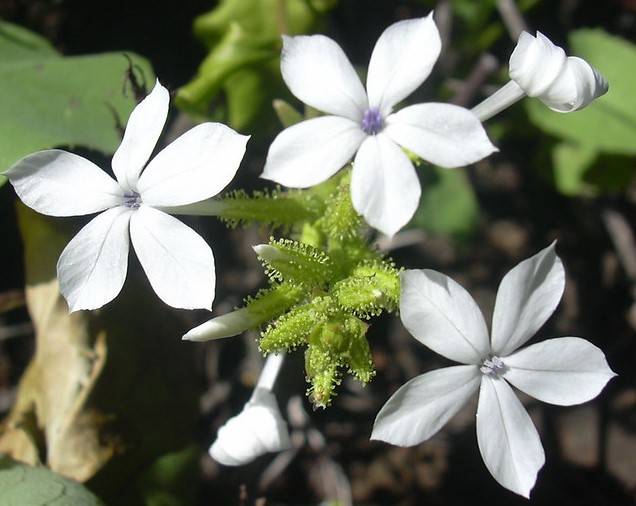Plant of the Month for August 2019 – Plumbago

Blue plumbago has an upright growth habit that makes it an excellent hedging plant.

Blue plumbago produces masses of true blue flowers virtually year round. (Photos courtesy / en.wikimedia.org)

The green seed pods of the native white plumbago have a sticky covering that adheres to whatever brushes against it. (Photo courtesy /Kim and Forest Starr)
To celebrate the 60th anniversary of Hawaiian Admission Day this Aug. 16, you might want to add the bright white-flowering native ground cover iliee to your garden. If youd prefer a blue flowering plant to complement your gardens color scheme, you could consider the non-native blue plumbago shrub. Each of these plants in the Plumbaginaceae family have some similarly attractive features as well as distinct differences beyond the color of their flowers.
To celebrate the 60th anniversary of Hawaiian Admission Day this Aug. 16, you might want to add the bright white-flowering native ground cover iliee to your garden. If you’d prefer a blue flowering plant to complement your garden’s color scheme, you could consider the non-native blue plumbago shrub. Each of these plants in the Plumbaginaceae family have some similarly attractive features as well as distinct differences beyond the color of their flowers.
Though the family includes more than 20 genera, only two are usually cultivated here. Though nearly 150 species are part of the limonium genera, only a few are grown here. Those are known by the common name statice and are known for their flowers that dry well and are used in long lasting arrangements. Those in the plumbago genera are more often found in Hawaiian gardens.
Plumbagos are sometimes referred to by the English name leadwort. The generic name is actually derived from the Latin words plumbum which means “lead” and agere which means “to resemble.” This nomenclature came from a name given by the Roman naturalist Pliny the Elder around 50 AD. It may have referred to the lead-blue color of the blue plumbago flower or to the lead-colored stain that the sap can create on the skin. For whatever reason, the centuries-old botanical name remains.
The white flowering plumbago, plumbago zeylanica, is known in Hawaii as iliee. It is an indigenous Hawaiian plant which means that it is native here as well as in other tropical areas. It appeared first in Hawaii in dryland forests as an understory plant. Today, it is frequently cultivated in gardens as a somewhat drought tolerant ground cover that is also described as a sprawling shrub. It grows quickly, making it an excellent plant to fill in an area and it can be used to help minimize erosion on slopes.
The dark green leaves of the native iliee present a pleasant contrast to the bright white star-shaped flowers that grow on short stalks or racemes. As many as five half-inch flowers can appear at the end of any of the white plumbago’s many stalks making a pleasant overall display.
Following flowering, the stalks carry the resulting seed-containing fruit of the plant. They are small oblong light green capsules that are somewhat sticky. The sticky capsules are the plant’s way of moving its seeds to new locations. When fully ripe the fruit will turn brown containing a single brown seed.
A fully mature iliee seed should be viable and will likely germinate in three or four weeks when planted in a good planting mix that is kept moist but not wet. Propagating iliee can also be done from cuttings. Select a semi-hard green stem 4-6 inches long, dip it in rooting compound and plant it in a rooting medium like vermiculite and perlite. Keep it moist and you should see new stem growth within a month.
Within a few months the seedlings or cuttings will start putting out new growth and will be ready to plant out. They will grow best in areas with partial shade. After about three months in the ground the plants should be well-established and should do fine without irrigation. If grown in full sun, iliee may require some irrigation. During our summer rainy season in Kona, the plants will put out new growth and spread quickly.
Like most plants, iliee will grow vigorously when lightly fertilized, though none is actually needed. In ideal conditions, they can grow stems up to 3 feet long in as little two months. These plants are not invasive but some pruning may be required to control growth.
Other than occasional pruning, iliee, has low maintenance requirements. It requires very little water or fertilizer and it is not usually attacked by pests or diseases. One reason that it does not attract pests is its inherent toxicity. Though it does have some traditional medicinal uses it should not be consumed by humans or other mammals.
Ants may live in the soil near the stems of a plumbago plant and can farm aphids, scale or mealy bugs. If you see ants near your plants, put out some outdoor ant bait. A soap and oil mix can be used against any sucking insects that might appear.
The blue plumbago, Plumbago auriculata, is similarly easy to maintain though it has a more erect growth habit than iliee. It can be grown as a tall, mounding ground cover or as a hedging plant, especially with some support, cascading over a wall or fence. In ideal growing conditions it can reach over six feet tall and grow just as wide.
Unlike the white plumbago, the blue is native to South Africa and is sometimes known as Cape plumbago. Though the flowers are similar in shape to iliee, they appear in several different shades of blue, depending on the variety.
The blue plumbago grows best in hot, full sun locations and produces tight clusters of flowers throughout the year. The flowers have slightly sticky petals that can adhere to people plants or animals that come into close proximity. Its leaves are light green and about 2 inches long.
Though blue plumbago differs somewhat from her native cousin in appearance, most of her qualities and tolerances similar. Water and fertilizer requirements are the same. Cultivation including pruning, propagation and pest control are also comparable.
Though iliee may be a bit more difficult to find in the trade, both the white and blue are wonderful plants, very easy to grow and maintain and ideally suited to Kona’s growing conditions. Look for them where plants are sold or find a friend who will give you cuttings and add a plumbago to your garden.
Diana Duff is a plant adviser, educator and consultant living part time in Kailua-Kona.
Gardening Events
Monday: “Proper Pesticide Use and Safety” from 10 a.m. to noon at the UH Cooperative Extension Service conference room in Kainaliu, across from the Aloha Theatre. Learn the current Worker Protection Standard for pesticide application taught by Cal Westergard of HDOA. Registration required at www.hawaiicoffeeed.com/wps or by calling Matt at 322-0164.
Wednesday: “Cacao Grafting Workshop” from 9-11 a.m. at the UH Cooperative Extension Service office in Kainaliu across from the Aloha Theatre. Learn hands on methods of grafting cacao with Eli Esele, Alyssa Cho and Max Breen. RSVP at https://sustainableagriculturehawaii.weebly.com under upcoming events.
Saturday: “Work Day at Amy Greenwell Garden” from 9 a.m. to 12:30 p.m. Meet at the Garden Visitor Center across from the Manago Hotel in Captain Cook. Volunteers will be able to help with garden maintenance and are invited to bring a brown bag lunch. Water and snacks provided. Call Peter at 323-3318 for more information.
Farmer Direct Markets
Wednesday: “Hooulu Farmers Market” 9 a.m. to 2 p.m. at Sheraton Kona Resort &Spa at Keauhou Bay
Saturday: “Keauhou Farmers Market” 8 a.m. to noon at Keauhou Shopping Center
“Kamuela Farmer’s Market” from 7:30 a.m. to 1 p.m. at Pukalani Stables
“Waimea Town Market” from 7:30 a.m. to noon at the Parker School in central Waimea
“Waimea Homestead Farmers Market” from 7 a.m. to noon next to Thelma Parker Gym in front of Thelma Parker Library.
Sunday: “Pure Kona Green Market” 9 a.m. – 2 p.m. at Amy Greenwell Garden in Captain Cook
“Hamakua Harvest” 9 a.m. to 2 p.m. at Highway 19 and Mamane Street in Honokaa
Plant Advice Lines Anytime: konamg@ctahr.hawaii.edu Tuesdays &Thursdays: 9 a.m. to noon at UH-CES in Kainaliu – 322-4892 Mon., Tues. &Fri: 9 a.m. to noon at UH CES at Komohana in Hilo 981-5199 or himga@hawaii.edu


